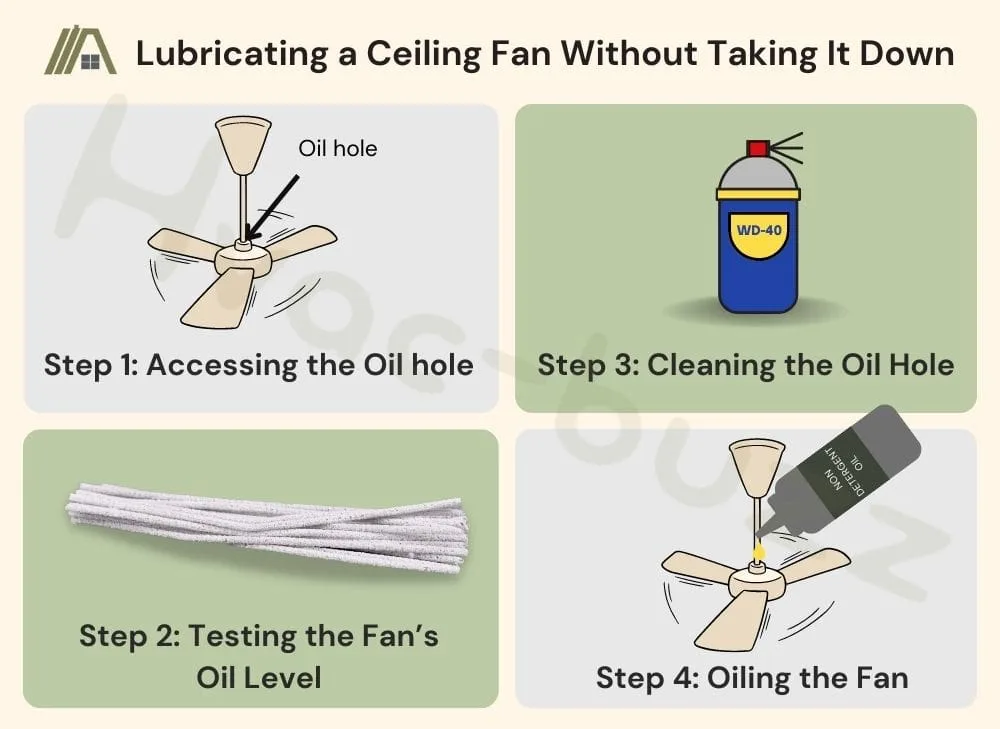There is only one thing more bothersome than having to listen to a squeaky ceiling fan and that’s having to disassemble it and take it all down in order to oil it. Fortunately, there’s a way to oil your ceiling fan without all the extra fuss.
Continue reading our step-by-step guide on how to safely lubricate your fan without needing to take it down!

Lubricating a ceiling fan is very simple. First, it is necessary to set up a ladder, access an oil hole, and clean it. Oil holes are often labeled and typically located near the top portion of the fan’s motor cover. After checking the oil levels, the hole can slowly be filled with recommended motor oil.
When to Lubricate Your Ceiling Fan?
Generally speaking, moving parts in machinery or appliances need to be lubricated for optimal performance, and ceiling fans are no exception. Most manufacturers recommend checking the ceiling fan oil levels at least once a year.
Lubrication not only prevents bothersome squeaking or grating noises, but also minimizes friction and prevents rust and corrosion from developing over time.
Failure to lubricate your fan can eventually cause it to stop working altogether!
It should be noted, however, that not every fan needs to be lubricated. Most newer models have self-lubricating, sealed ball bearings. This releases you from having to perform this type of maintenance.
Be sure to look at your fan’s manual or look up care for your fan model online to see if your fan needs lubrication, and how often it should be done.
Tools You’ll Need
What Oil to Use?
Not just any oil will do. When it comes to ceiling fans, since what you are lubricating is actually part of the motor, you will want to use motor oil. In this case, the ideal oil to use is non-detergent motor oil 10, 15, or 20-weight.
Technically some other oils may work, such as olive oil or white mineral oil. However, we don’t recommend anything else in place of motor oil (or whatever oil is recommended in your fan’s manual).
Safety Precautions
As always, safety first! We don’t take any precautions lightly, as even simple tasks like this can result in serious harm if the proper steps aren’t taken.
Always Consult the Manual
As mentioned earlier in the article, you should be sure to consult your manual before oiling your fan. It may turn out that oiling isn’t necessary, that oiling doesn’t need to be done very frequently, or that your fan model needs a very particular oil.
Doing things “by the book” can save you a headache. It will also save your fan from unnecessary damage or strain, keeping your wallet safe as well!
Turn off the Electric Outlet
You don’t want any electricity running to the fan while you’re working on it, even if you’re not planning on touching the wires.
Make sure your fan itself is off, turn off the wall switch (if applicable), and most importantly, flip off the breaker to your fan before you begin.
This might sound excessive, but an electrical shock is no joke. It’s better to be safe than sorry.
Using a Ladder
It’s very likely your fan is too high to reach easily, so you’ll need to stand on something.
Make sure you use the proper tool, such as a ladder, not any furniture like a chair (and especially not a swivel chair!).
Be sure to follow safe ladder practices as well. Make sure it’s tall enough, and place it in such a way you won’t have to lean. Secure your ladder’s lock, if it has one, and ensure that it is on a flat surface and not able to wobble.

Lubricating a Ceiling Fan Without Taking It Down
Step 1: Accessing the Oil hole
To access your fan’s oil hole, you’ll need to set up your ladder so that you are able to search around the top portion of your fan’s engine.
The oil hole should be quite small, and it may even be labeled.
If you cannot find the oil hole, double-check your fan’s manual again to make sure there is one and to figure out where it should be. It may turn out that there is no oil hole, and your fan is a self-lubricating model.
Step 2: Testing the Fan’s Oil Level
To test your fan’s oil level, you’ll need to use a pipe cleaner.
- Bend it into a “J” shape, making sure that the short end is about ½” long.
- You’ll then turn the pipe cleaner so that the bend is facing upwards, like a candy cane. Insert the short, ½” section into the oil hole, then remove it.
- If you see oil on the pipe cleaner, your reservoir is still full.
- If you do not see oil on the pipe cleaner, you should continue with the lubrication process.
Step 3: Cleaning the Oil Hole
Since cleaning removes any dust and gunk, it’s less likely that it will find its way inside your fan’s engine.
The more dirt that makes its way into your fan’s oil hole, the gummier it will get inside, preventing your fan from rotating smoothly and running well.
That is why it is important to clean around the oil hole as best you can, either with a damp rag or WD-40 (but you can’t use this oil inside your ceiling fan!). You may slightly clean the inside of the oil hole, but take care not to lose anything inside the hole.
Step 4: Oiling the Fan
After cleaning around the oil hole, wait for any lingering dampness to dry. You then may begin filling your oil hole.
Be sure to go slow and be careful not to overfill. After you are done, if there is any mess, be sure to clean around the hole again.
How Much Oil Do You Need?
The amount of oil needed is determined by your fan’s model and by how long it has been since the last oiling.
You’ll generally need 1-2 oz. of oil, although sometimes you might need up to 3 oz. It’s difficult to say beforehand how much one will need, which is why we recommend going slow.

To reduce the risk of overfilling, pour a small amount into the oil hole at a time. Try to wait a few seconds for the oil to settle between fillings, and check the oil level with the pipe cleaner you used before. If you cannot see the oil, continue filling.
Once oil can be seen on the pipe cleaner, you’ll know to stop.
Sources
https://homeaffluence.com/how-to-oil-a-ceiling-fan-without-taking-it-down/
https://homeguides.sfgate.com/dyson-v8-worth-cost-13772127.html
https://www.hunker.com/13416378/how-to-oil-a-ceiling-fan
https://hvacguides101.com/how-to-oil-a-ceiling-fan-without-taking-it-down/
https://hvacseer.com/do-ceiling-fans-need-to-be-oiled/
https://www.thisoldhouse.com/home-safety/21017790/how-to-use-a-ladder-safely

